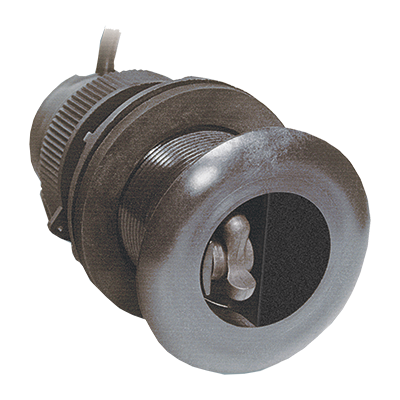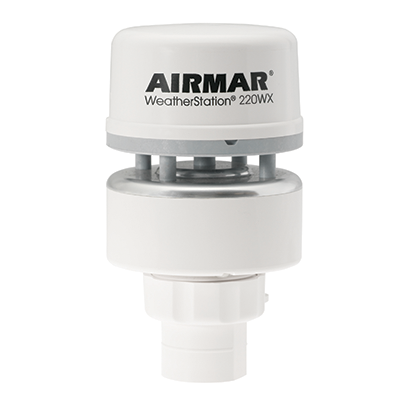Recently we have seen a trend in customers asking about using smart transducers with our iKommunicate, rather than installing the more traditional; Log, Depth, Wind and navigation instruments.
If you are re-fitting an older boat or doing an install on a new boat, then it is worth considering the cost benefits and simplicity of design that this approach provides. Whether you create an NMEA2000 backbone or simply wire together NMEA0183 cables, having iKommunicate receive all of the transducer data and then distribute this over a wired or wireless Ethernet network, where the data can be displayed on multiple tablets, phones or computers around the boat is very desirable.
One of the most common questions is…”What transducers should I use?” and so we thought we would tackle this question in this article.
When it comes to transducers, the leading player by a mile, is Airmar the US company that manufacture transducers for pretty much all of the big players in marine electronics. As a result, their product catalogue is massive and finding the right model and part number can be pretty daunting and time consuming, so we have tried to highlight the ideal transducers in their range for using with iKommunicate and listed the Gemeco Part Numbers (SKUs) who are Airmar’s US distributor and whose website is very informative.
The obvious “through the hull” Speed and Depth transducer for most yachts and powerboats, would be the DST800. Described as a “Triducer” as it has a Speed, Depth and Temperature sensor, the DST800 is fully retractable for cleaning, with an integral valve that significantly reduces water ingress. It is available in Plastic, Bronze or Stainless Steel, with both NMEA0183 or NMEA2000 versions.
The NMEA0183 version, which can be used on 12v or 24v systems, comes with 10m of cable, terminated in bare wires and you simply add an S to the end of the part number for this version i.e. DST800PV-S.
The NMEA2000 version, powered from the NMEA2000 network, comes with 6m of cable, terminated in the “standard” male NMEA2000 connector (same one as iKommunicate) and for this version you simply add N2 to the part number i.e. DST800PV-N2.
| Gemeco SKU | Description |
| DST800PV-S | NMEA0183 – 235kHz Smart Triducer – Plastic |
| DST800BV-S | NMEA0183 – 235kHz Smart Triducer – Bronze |
| DST800SV-S | NMEA0183 – 235kHz Smart Triducer – Stainless |
| DST800PV-N2 | NMEA 2000 – 235kHz Smart Triducer – Plastic |
| DST800BV-N2 | NMEA 2000 – 235kHz Smart Triducer – Bronze |
| DST800SV-N2 | NMEA 2000 – 235kHz Smart Triducer – Stainless |
So with the DST800, you get Speed (through the water), Depth and water temperature, plus as a bonus a distance log as well, which just leaves the Wind to worry about.
With the Wind transducer Airmar really “threw away the rule book” for designing Mast Head Units by removing all moving parts and using ultrasonics to measure wind angle and speed. Although not ideal for every type of boat, the 120WX and 220WX Weatherstation® instruments are really good bits of kit which not only measure the wind, but also air pressure and air temperature and in the case of the 220WX, with integral GPS and Compass sensors, even your position, heading, rate of turn and attitude (pitch and roll).
Above is an image of the 220WX which is physically identical to the 120WX.
Both units have NMEA0183 and NMEA2000 built-in, so no different versions to worry about, you simply order either a WS-120WX or WS-220WX and specify the type and length of cable you need;
| Gemeco SKU | Description |
| WS-C10 | NMEA0183 – 10m |
| WS-C25 | NMEA0183 – 25m |
| WS2-C06 | NMEA2000 – 6m |
| WS2-C10 | NMEA2000 – 10m (Terminated) |
| WS2-C30 | NMEA2000 – 30m (Terminated) |
There are other lengths available but we have listed the most popular for Yachts and Power Boats. The two NMEA2000 cables that have (Terminated) after them, include the NMEA2000 termination resistor and must be mounted at the end of the NMEA2000 network.
Should your budget not stretch to an ultrasonic wind transducer or you prefer a more traditional mast head unit, then our own WND100 wind transducer which comes with a 20m NMEA0183 cable is well worth considering, perhaps coupled with our HSC100 smart heading sensor and GPS160 TriNav position sensor both of which have NMEA0 183 outputs to connect to one of the three NMEA0183 inputs on iKommunicate.
So you have your iKommunicate and smart transducer setup, but what options are there for displaying the data? Well you have plenty of PC Navigation packages; Nobeltec, Rosepoint, Fugawi, Seapro, MaxSea, SmarterTrack, etc. and then Apps like NMEA Remote, iSailor, iNavX, iRegatta, SailRacer, TimeZero, Imray etc are perfect for running on your Apple iPhone/iPad or Android phone/tablet in the cockpit. If you want a dedicated display then perhaps a single graphical display from Garmin, Raymarine, Simrad, etc. or a mast display from NASA or Race Geek would give you a permanent cockpit display without breaking the bank.
Finally with iKommunicate you also have the option of running the new Signal K web apps in your browser so any mobile wireless device can display the data on a modern web browser,even a Kindle !







hi there
Out of interest, would its be feasible to wire up an older “B&G network” wind transducer to the I Kommunicate? I would like to route the signal to a tablet or to some new displays like NASA or Racegeek.
I don’t know if B&G Network Wind gives out an NMEA 0183 signal or something proprietary.
Any feedback is much appreciated.
Cheers
Hi Michael,
Wow, the B&G Network range of instruments is going back a few years.
My memory not being what it used to be, I had to double check an old manual I found online (http://www.chicagomarineelectronics.com/Documents_B&G/Net/NET-Data_man.pdf) and this confirmed that B&G used an NMEA0183 interface to communicate data between the instruments, so it should be possible to tap in to this somehown and connect it to one of the iKommunicate’s NMEA0183 inputs.
I could not find exact details of the B&G Network wiring but I am sure with a bit more investigation you could find out this information.
Hope this helps.
Best regards
PAUL
thanks Paul. I will do some more homework but i will probably replace the unit with the Wind 100 transducer. I suspect a replacement unit offers better return for the $$ and is less risky re implementation. Cheers
I have a 220WX. It is configured and calibrated and working well. I can see all of the 220WX sensor data converted thru the ikommunicate except roll and pitch. Roll and pitch work well on my chart plotter via native nmea2000, but are not being converted to signalk via the ikom. Ikom is running current firmware. I would love to see those pgn’s passed through. Any idea when this may happen?
Hi Garnet,
We do not currently convert Roll and Pitch PGN data to Signal K but we will add that to the new feature “wish list” and try to get them supported ASAP.
Best regards
PAUL